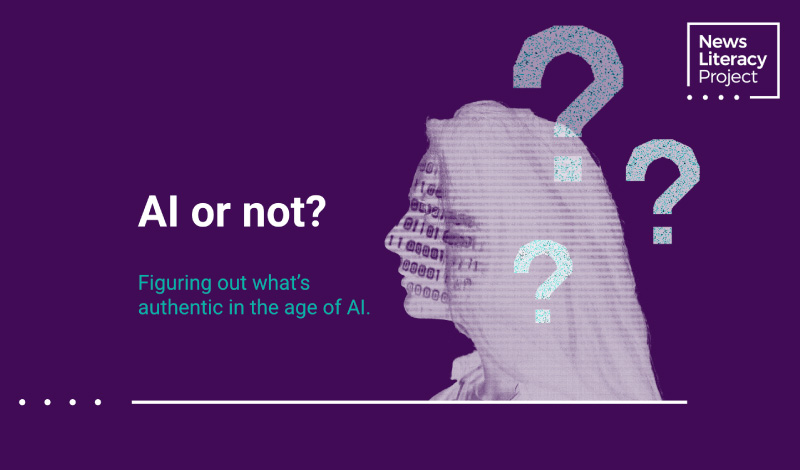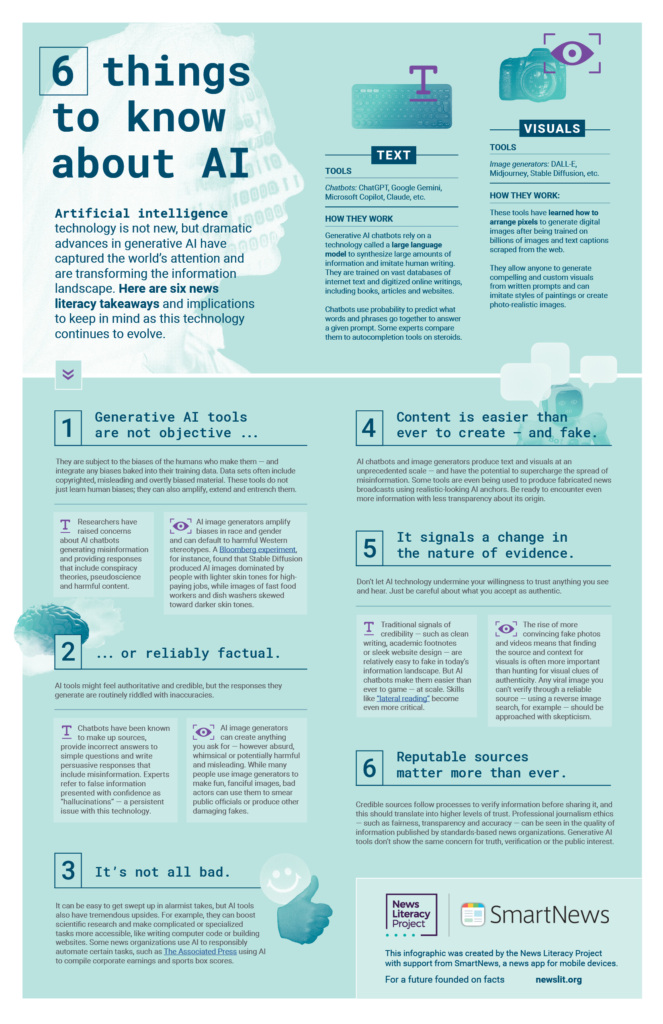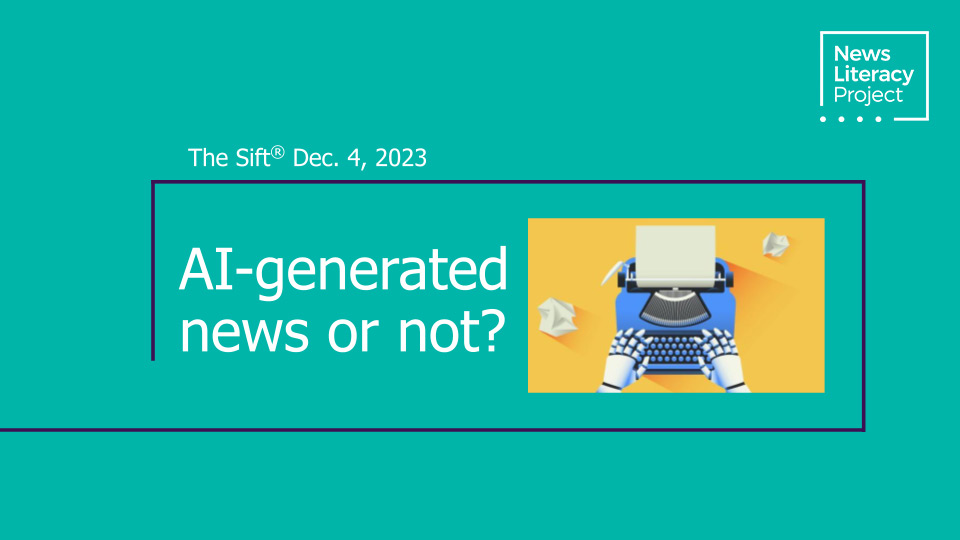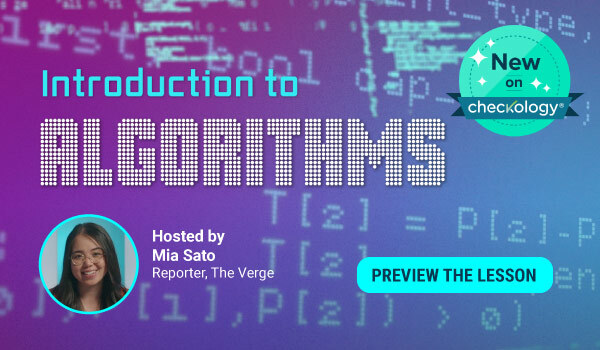Slides: AI-generated news or not?
As artificial technology advances and standards-based news organizations incorporate it into their work, it can be challenging to determine whether online text is AI-generated. While some news organizations have used AI for years for tasks like transcribing interviews, analyzing data or generating reports, the technology is also used by bad actors to spread false or misleading information on social media and through “pink slime” sites that masquerade as local news.
Use these classroom-ready slides with students to determine whether three examples of news articles are AI-generated or written by journalists.
Discuss: How can you tell if AI technology is used to produce a news story? What are some pros and cons of news organizations using AI? How could AI be used by newsrooms in an ethical and transparent way that aligns with the standards of quality journalism?
These slides originally appeared in the Dec. 4, 2023, issue of The Sift®, a newsletter for educators that explores timely examples of misinformation, addresses journalism and press freedom topics and examines social media trends and issues. Read archives of the newsletter and subscribe here.
AI or not?


In this lesson, students consider the impact of generative AI technology on the information landscape. They start by completing a K-H-W-L chart. Then students take a short quiz featuring AI-generated images and explore tips to determine whether an image is AI-generated. Finally, students will reflect on how AI tools have changed the nature of visual evidence.
Intended for grades 6 and up, this lesson plan includes essential questions, vocabulary, activity slides, procedural directions and ideas for an extension opportunity.
Below is a preview of several lesson elements:
NLP standard 4: Students demonstrate increased critical habits of mind, including effective verification skills and the ability to detect misinformation and faulty evidence.
Essential Questions
- How can you tell if something is AI-generated or authentic?
- How have AI tools changed the ways you evaluate visual evidence for online claims?
- What problems can arise when people mistake AI content as authentic? What about when they dismiss authentic visuals as AI-generated?
Vocabulary
- Artificial intelligence: Technology that aims to replicate the way the human mind works to perform a wide variety of tasks, including analyses and comparisons that go beyond what people’s minds can do.
- Generative AI: Layers of powerful algorithms that learn patterns in data and then use this understanding to create new content. These tools are capable of producing text and synthetic images, video and audio.
6 things to know about AI


Artificial intelligence technology is not new, but dramatic advances in generative AI have captured the world’s attention and are transforming the information landscape.
This infographic provides an overview of how this technology works and offers six news literacy takeaways to keep in mind as these tools evolve:
- Generative AI tools are not objective: They are subject to the biases of the humans who make them, and any biases in the training data may show up when they are used.
- . . .or reliably factual: AI tools might feel authoritative and credible, but the responses they generate are routinely riddled with inaccuracies.
- It’s not all bad: AI tools also have tremendous upsides. (For example, they can boost scientific research and make complicated or specialized tasks more accessible, like writing computer code or building websites.)
- Content is easier than ever to create — and fake: AI chatbots and image generators produce text and visuals at an unprecedented scale — and have the potential to supercharge the spread of misinformation. Be ready to encounter even more information with less transparency about its origin.
- It signals a change in the nature of evidence: The rise of more convincing photos and videos means that determining the source and context for visuals is often more important than hunting for visual clues of authenticity. Any viral image you can’t verify through a reliable source — using a reverse image search, for example — should be approached with skepticism.
- Reputable sources matter more than ever: Credible sources follow processes to verify information before sharing it, and this should translate into higher levels of trust.
Don’t let AI technology undermine your willingness to trust anything you see and hear. Just be careful about what you accept as authentic.
Learn more in Checkology: Introduction to Algorithms
In this lesson on the Checkology® virtual classroom, students explore algorithms and generative artificial intelligence.
News Goggles: Kent Porter, The Press Democrat
Photos and videos are a crucial form of reporting and storytelling in journalism. They can add context, hold the powerful accountable and offer a window into people’s lived experiences.
This week, we talk to Kent Porter about his work as a photojournalist at the Santa Rosa Press Democrat in Northern California. We examine the role of ethics in visual journalism, including the steps photojournalists take to document stories accurately and fairly. Porter explains how he has earned the trust of his community after covering the area for more than three decades. He also shares his perspective on the rise of artificial intelligence to generate images and underscores why photojournalism remains important in the digital age. Grab your news goggles!
Note: Look for this newsletter feature the first Monday of the month. You can explore previous News Goggles videos, annotations and activities in NLP’s Resource Library under “Classroom Activities.”
Resource: “Practicing Quality Journalism” (NLP’s Checkology® virtual classroom).
Idea: Contact a local visual journalist and ask them to discuss the role of standards and ethics in their daily work.
Another Idea: Examine a recent news story that includes photos or videos from a visual journalist. How do these visuals impact the news coverage? How do they contribute to your understanding of the topic? What would your experience with news be like if there were no photos or videos?
Dig Deeper: Use this viewing guide for the featured News Goggles video to help students take notes on what it means to be a photojournalist.
News Goggles annotations and activities provide news literacy takeaways on timely topics. These resources feature examples of actual news coverage, including full news reports, headlines, breaking news alerts or excerpts.
This video originally appeared in the April 3, 2023, issue of The Sift® newsletter for educators, which explores timely examples of misinformation, addresses journalism and press freedom topics and examines social media trends and issues. Read archives of the newsletter and subscribe here. Stock music in this video was provided by SoundKit from Pond5.
Have feedback about this resource? Or an idea for a future News Goggles? Please share it with us at [email protected].

